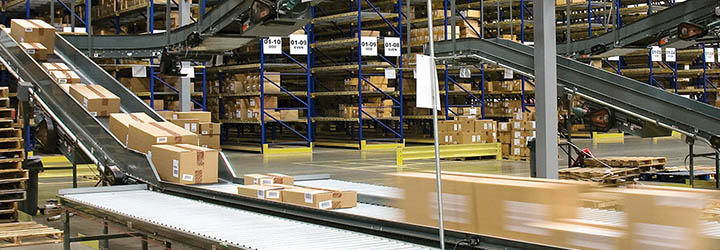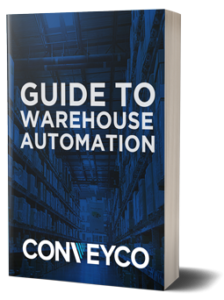
Case conveyors come in all sorts of shapes, sizes , and functions. They are mainly used to move cases of product from one area of a warehouse to another. They come in standard sizes and are usually measured in the Between Frame (BF) dimension. The width of case conveyors is one of the first things engineered as smaller BF conveyors cost less, but also can conveyor a smaller product range.
Individual conveyors are installed together in a myriad of configurations to accommodate spatial, throughput, and operational requirements. These groups of conveyors would represent a conveyor system, with each conveyor engineered to work together to move, sort, and stage cartons.
Belt conveyors are used for their positive traction on corrugate and can be used to incline/ decline the conveyor system, gap cartons for decision points, and fill specialty operations. Accumulation conveyors are typically roller driven conveyors that use sensors to queue product from one functional area to the next allowing the system to flow without stopping one area and causing bottlenecks. Live roller conveyors transport cases help run conveyor lines around curves and merges, while gravity conveyors allow the cases own velocity (including humans pushing the case) to convey from one area to the next.
Belt Conveyors are useful for their positive grip on a case. They can be used to convey cases up, or down.
Need an Expert Opinion?

Why a Case Conveyor System Makes Sense for your Operation
Weather you use AS/RS, picking software, or Autonomous Mobile Robots (AMRs), most systems will require some type of case conveyor system. It is the most economical way to transport high volumes of cases from one operational area (or zone) to the next. Case conveyors can also be used to merge cases from separate areas of the warehouse together, and even sort a single line of cases into many (sorting to pallet build or dock door locations for example.
Features
The wide array of case conveyor styles and models available provide a vast number of unique features and qualities to handle a wide variety of cases, cartons and totes.
- Standard widths from 16” to 40” between frame
- Speeds from 90 Feet per minute up to 600 FPM
- 480v and 24v motors available
- Premium efficient motors use less electricity
- Guardrails used to keep product on the conveyor
Benefits
There are many benefits to using case conveyor including:
- Reduces Forklift traffic, labor floorspace and machines
- Ergonomic picking
- Dramatically reduces walking for warehouse employees
- Can merge and sort cartons by many variables
- Brings cartons from distant areas of the warehouse to common points for shipping
Applications
Case conveyors have a wide array of applications. Each type is designed with a specific application in mind and they must be applied with care as each conveyor affects the one upstream and the one down stream.
- Flexible for all distribution channels
- Accumulation can be used as process buffer
- Can be used in conjunction with other technologies
- Excellent ability to sort groups of cases into specific areas for processing and/ or shipping
Specifications
- Standard widths from 16” to 40” between frame
- Speeds from 90 Feet per minute up to 600 FPM
- 480v and 24v motors available
Case Conveyor Specifications to Be Aware of:
- Load Capacity – understanding your load capacity requirements is vital proper system engineering and function
- Accumulation Logic – Different styles of accumulation lead to different throughput rates.
- Conveyor Speed – often rated in terms ft/min.
- Case Feet per Minute – CFPM is a combination of conveyor speed and conveyor type or release type
- Throughput – measures the capacity of conveyors and is often stated as cases per unit time, for instance, as 6,000 cases per hour
- Frame Configuration – Frame configuration refers to the shape of the conveyor frame. Depending on your requirements, the frames can be straight, curved, z-frames, or other shapes.
- Drive Location – Some conveyors must have drives is specific locations, while others can be mounted in more convenient locations. Understanding the drive locations can be a big help to maintenance teams down the road.
Why Work With Conveyco
Conveyco has been applying conveyor to order fulfillment systems for over 40 years. Our engineering department can apply conveyor creatively to minimize capital expense while keeping the system functioning as one cohesive unit. There is a fine line between minimizing costs without giving away functionality. Each situation is different, and Conveyco knows where conveyor capital is best spent, and where the opportunities for value engineering exist.
Conveyco has spent decades building relationships with the best in breed conveyor lines to allow a wide array of tools curated to pick the manufacturers that best fit each application.
Conveyor Resources

Accuglide Conveyor: Common Repairs, Upgrades & Spare Parts

TGW Conveyors: Common Repairs, Upgrades & Spare Parts


